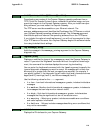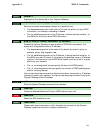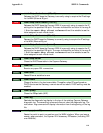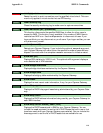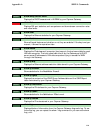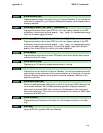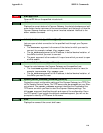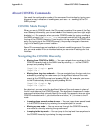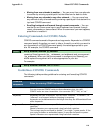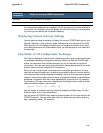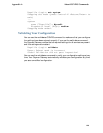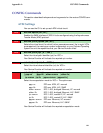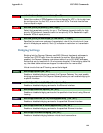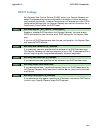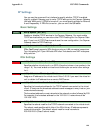
118
Appendix A About CONFIG Commands
•
Moving from one subnode to another — You can move from one subnode
to another by entering a partial path that identifies how far back to climb.
• Moving from any subnode to any other subnode — You can move from
any subnode to any other subnode by entering a partial path that starts with a
top-level CONFIG command.
• Scrolling backward and forward through recent commands — You can
use the Up and Down arrow keys to scroll backward and forward through
recent commands you have entered. When the command you want appears,
press Enter to execute it.
Entering Commands in CONFIG Mode
CONFIG commands consist of keywords and arguments. Keywords in a CONFIG
command specify the action you want to take or the entity on which you want to
act. Arguments in a CONFIG command specify the values appropriate to your
site. For example, the CONFIG command
consists of three keywords (ip
, ethernet, and address) and one argument
(ip_address). When you use the command to configure your Gateway, you
would replace the argument with a value appropriate to your site.
For example:
Guidelines: CONFIG Commands
The following table provides guidelines for entering and formatting CONFIG
commands.
BOTH set ip ethernet address
ip_address
BOTH set ip ethernet address 192.31.222.57
Command
component
Rules for entering CONFIG commands
Command verbs CONFIG commands must start with a command verb (set, view, delete).
You can truncate CONFIG verbs to three characters (set, vie, del).
CONFIG verbs are case-insensitive. You can enter “SET,” “Set,” or “set.”
Keywords Keywords are case-insensitive. You can enter “Ethernet,” “ETHERNET,” or
“ethernet” as a keyword without changing its meaning.
Keywords can be abbreviated to the length that they are differentiated from
other keywords.
Argument Text Text strings can be as many as 64 characters long, unless otherwise
specified.
Special characters are represented using backslash notation.
Text strings may be enclosed in double (“) or single (‘) quote marks. If the
text string includes an embedded space, it must be enclosed in quotes.
Special characters are represented using backslash notation.



